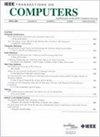PQNTRU: Acceleration of NTRU-Based Schemes via Customized Post-Quantum Processor
IF 3.6
2区 计算机科学
Q2 COMPUTER SCIENCE, HARDWARE & ARCHITECTURE
引用次数: 0
Abstract
Post-quantum cryptography (PQC) has rapidly evolved in response to the emergence of quantum computers, with the US National Institute of Standards and Technology (NIST) selecting four finalist algorithms for PQC standardization in 2022, including the Falcon digital signature scheme. Hawk is currently the only lattice-based candidate in NIST Round 2 additional signatures. Falcon and Hawk are based on the NTRU lattice, offering compact signatures, fast generation, and verification suitable for deployment on resource-constrained Internet-of-Things (IoT) devices. Despite the popularity of ML-DSA and ML-KEM, research on NTRU-based schemes has been limited due to their complex algorithms and operations. Falcon and Hawk's performance remains constrained by the lack of parallel execution in crucial operations like the Number Theoretic Transform (NTT) and Fast Fourier Transform (FFT), with data dependency being a significant bottleneck. This paper enhances NTRU-based schemes Falcon and Hawk through hardware/software co-design on a customized Single-Instruction-Multiple-Data (SIMD) processor, proposing new SIMD hardware units and instructions to expedite these schemes along with software optimizations to boost performance. Our NTT optimization includes a novel layer merging technique for SIMD architecture to reduce memory accesses, and the use of modular algorithms (Signed Montgomery and Improved Plantard) targets various modulus data widths to enhance performance. We explore applying layer merging to accelerate fixed-point FFT at the SIMD instruction level and devise a dual-issue parser to streamline assembly code organization to maximize dual-issue utilization. A System-on-chip (SoC) architecture is devised to improve the practical application of the processor in real-world scenarios. Evaluation on 28PQNTRU:通过自定义后量子处理器加速基于ntruu的方案
随着量子计算机的出现,后量子密码学(PQC)迅速发展,美国国家标准与技术研究院(NIST)在2022年为PQC标准化选择了四种最终入围算法,其中包括猎鹰数字签名方案。Hawk是目前NIST第二轮附加签名中唯一基于格子的候选。Falcon和Hawk基于NTRU晶格,提供紧凑的签名、快速生成和验证,适合部署在资源受限的物联网(IoT)设备上。尽管ML-DSA和ML-KEM很受欢迎,但基于ntrus的方案由于其复杂的算法和操作而受到限制。由于在数论变换(NTT)和快速傅立叶变换(FFT)等关键操作中缺乏并行执行,Falcon和Hawk的性能仍然受到限制,数据依赖性是一个重要的瓶颈。本文通过在定制的单指令多数据(SIMD)处理器上进行硬件/软件协同设计,增强了基于ntru的Falcon和Hawk方案,提出了新的SIMD硬件单元和指令,以加快这些方案的速度,并通过软件优化来提高性能。我们的NTT优化包括一种新颖的SIMD架构层合并技术,以减少内存访问,并使用模块化算法(Signed Montgomery和Improved Plantard)针对各种模量数据宽度来提高性能。我们探索了应用层合并来加速SIMD指令级的定点FFT,并设计了一个双问题解析器来简化汇编代码组织,以最大限度地利用双问题。设计了片上系统(SoC)架构,以提高处理器在实际场景中的实际应用。对28nm技术和现场可编程门阵列(FPGA)平台的评估表明,我们的设计和优化可以将Hawk签名生成和验证的性能提高7倍以上。
本文章由计算机程序翻译,如有差异,请以英文原文为准。
求助全文
约1分钟内获得全文
求助全文
来源期刊

IEEE Transactions on Computers
工程技术-工程:电子与电气
CiteScore
6.60
自引率
5.40%
发文量
199
审稿时长
6.0 months
期刊介绍:
The IEEE Transactions on Computers is a monthly publication with a wide distribution to researchers, developers, technical managers, and educators in the computer field. It publishes papers on research in areas of current interest to the readers. These areas include, but are not limited to, the following: a) computer organizations and architectures; b) operating systems, software systems, and communication protocols; c) real-time systems and embedded systems; d) digital devices, computer components, and interconnection networks; e) specification, design, prototyping, and testing methods and tools; f) performance, fault tolerance, reliability, security, and testability; g) case studies and experimental and theoretical evaluations; and h) new and important applications and trends.
 求助内容:
求助内容: 应助结果提醒方式:
应助结果提醒方式:


